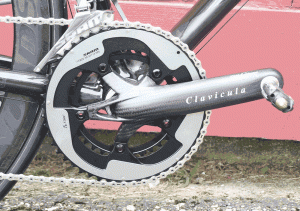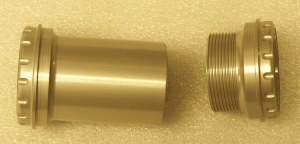Ultra-Light Guru Photon – Installment 4, Cranks & Cables
by Jim Weaver, Service Manager, Fit Werx VT
CRANKSET, BOTTOM BRACKET & CABLES
The crankset is a big and heavy component on a bike and a source of considerable weight savings. However, light, strong and stiff may be contrary goals. There are many, many choices of light-weight cranks on the market and some are better than others. After much research, we found the Clavicula Compact carbon crankset, from THM-Carbones Carbon Components. This is the most exotic component on this bike. The Clavicula is a full carbon fiber crankset with an alloy axle, and comes without chainrings. The “beefy” arm design and carbon lay-up makes for a very stiff  crankset, while still being aesthetically very pleasing. THM’s website shows the results of independent testing, with the Clavicula demonstrating a stiffness-to-weight ratio superior to any other crankset they tested, from the Stork Powerarms, through the now regrettably no longer available Zipp Vuma Quad, Campagnolo Record, Shimano Dura Ace, SRAM Red, FSA, Stronglight…well you get the idea; they pretty much listed every crankset that I have ever heard of, and some I have not. THM advertises a weight of 420 grams, without chainrings. We installed SRAM Red 2012 chainrings, due to their new design, shifting improvement, light weight and intended compatibility with the rest of the RED group. The combination of crank and chainrings is 495 grams according to our shop scale – that is light – well over 100 grams lighter than a SRAM Red 2012 crank and chainrings. So, we have a super light crankset and chainrings that is also stiffer. A win-win proposition, as they say.
crankset, while still being aesthetically very pleasing. THM’s website shows the results of independent testing, with the Clavicula demonstrating a stiffness-to-weight ratio superior to any other crankset they tested, from the Stork Powerarms, through the now regrettably no longer available Zipp Vuma Quad, Campagnolo Record, Shimano Dura Ace, SRAM Red, FSA, Stronglight…well you get the idea; they pretty much listed every crankset that I have ever heard of, and some I have not. THM advertises a weight of 420 grams, without chainrings. We installed SRAM Red 2012 chainrings, due to their new design, shifting improvement, light weight and intended compatibility with the rest of the RED group. The combination of crank and chainrings is 495 grams according to our shop scale – that is light – well over 100 grams lighter than a SRAM Red 2012 crank and chainrings. So, we have a super light crankset and chainrings that is also stiffer. A win-win proposition, as they say.
The Clavicula Bottom Bracket, designed for use with the Clavicula crankset, is a BB30  design. However, unlike the typical BB30 design, the bearings are not set inside the bike frame, but rather external cups. For most carbon frames on the market, the bottom bracket bearings are in a separate shell, usually plastic of some sort, that is pressed into the frame. Nothing holds this shell in place, other than the tight fit. If that fit is not tight, woe is me as the technician trying to correct a creaking bottom bracket. The Clavicula BB shell is not plastic, but an aluminum alloy, so it is stronger and more durable. This BB shell only presses in a small amount, approx. 5mm, far less than most. Well, I guess “presses in” is not really correct – “squeezes together” is more accurate. This Clavicula BB is firmly held in place because the two halves of the shell are actually threaded, and they screw together, thus squeezing the bottom bracket into place. Threading the two halves together, makes for a very tight fit that does not depend on exact tolerances for fitting of the bottom bracket shell into the hole in the frame. Also, by placing the bearings outside the frame stiffness is further enhanced as the bearings are wider. This helps prevent the crank axle from deflecting under load, making for a stiffer crankset/bottom bracket combination. For weight comparisons, a SRAM PressFit 30 shell and bearings is 95 grams, and our most popular BB (Hawk Racing), a traditional BSA external cup design, is also 95 grams. These are marginally lighter than the 104 gram Clavicula. However, the Clavicula is an all-alloy shell, with no plastic parts, so it should prove less likely to creak, better aligned and stiffer than the SRAM PressFit 30. Oh, and did I mention that the bearings are wonderful? Once installed, the crank spins much more freely than with most other BB30-type bearings I have seen, at least partially because of the alignment the threaded shell design creates. We felt that sacrificing a few grams for increased durability, stiffness and free spinning was a worthwhile trade-off.
design. However, unlike the typical BB30 design, the bearings are not set inside the bike frame, but rather external cups. For most carbon frames on the market, the bottom bracket bearings are in a separate shell, usually plastic of some sort, that is pressed into the frame. Nothing holds this shell in place, other than the tight fit. If that fit is not tight, woe is me as the technician trying to correct a creaking bottom bracket. The Clavicula BB shell is not plastic, but an aluminum alloy, so it is stronger and more durable. This BB shell only presses in a small amount, approx. 5mm, far less than most. Well, I guess “presses in” is not really correct – “squeezes together” is more accurate. This Clavicula BB is firmly held in place because the two halves of the shell are actually threaded, and they screw together, thus squeezing the bottom bracket into place. Threading the two halves together, makes for a very tight fit that does not depend on exact tolerances for fitting of the bottom bracket shell into the hole in the frame. Also, by placing the bearings outside the frame stiffness is further enhanced as the bearings are wider. This helps prevent the crank axle from deflecting under load, making for a stiffer crankset/bottom bracket combination. For weight comparisons, a SRAM PressFit 30 shell and bearings is 95 grams, and our most popular BB (Hawk Racing), a traditional BSA external cup design, is also 95 grams. These are marginally lighter than the 104 gram Clavicula. However, the Clavicula is an all-alloy shell, with no plastic parts, so it should prove less likely to creak, better aligned and stiffer than the SRAM PressFit 30. Oh, and did I mention that the bearings are wonderful? Once installed, the crank spins much more freely than with most other BB30-type bearings I have seen, at least partially because of the alignment the threaded shell design creates. We felt that sacrificing a few grams for increased durability, stiffness and free spinning was a worthwhile trade-off.
Our shop standard cables and housings, by Jagwire, are very fine products, and are a great value. As an aside, one of the best, and most economical, ways you can improve the shifting of your bike, and one of the most ignored, is to replace your cables and housings ever y year or two. A bit like car brakes that are wearing out, you may not realize how much shifting performance has degraded until you replace the cables and housings. Anyway, despite how good Jagwire products are and how good stock RED cables and housing are, there are lighter alternatives out there. We selected Power Cordz brake and derailleur cables and housings, from IO DuPont of Boise, Idaho. These are 75% lighter than conventional cables and housings, and the cables themselves are stronger than the stainless steel cables common on the market. The thickness and feel of the cables belie their strength. Each cable has over 5,000 strands of synthetic fibers encased in a nylon sheathing. These cables do not stretch like steel cables. Also, dirt has a difficult time adhering to the nylon sheathing, which is quite slippery, so shifting problems from dirty cables are minimized. The housing is very light, with minimal wire used in forming the housing, and wrapped with what appears to be the same synthetic fiber used in the cables. Installation is a bit tricky, but not too hard if you follow the directions carefully. I made a few modifications to the way these cables were secured to the brakes, necessitated by the design of the Zero Gravity brakes’ cable fixing bolt, to insure that the brake cables would not slip. Once installed, these cables worked great, but are not great if you tighten and loosen your cable fixing bolts often as they can crush. Power Cordz makes cables and housings for both road and mountain bikes, and they are compatible with Shimano, SRAM and Campagnolo.
Next – Other necessary bits…

